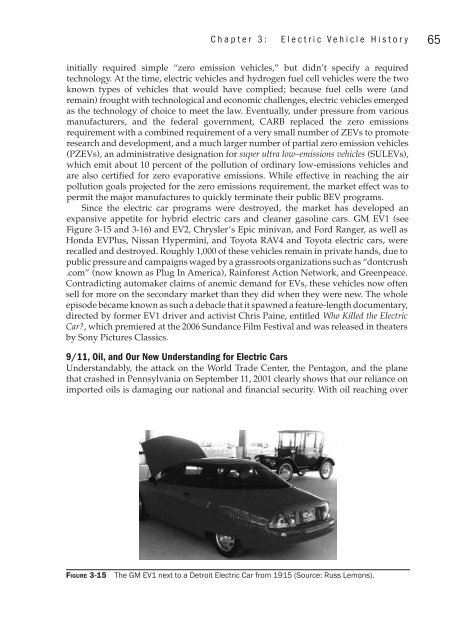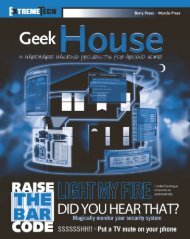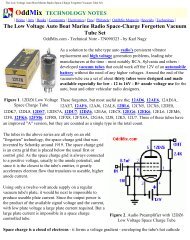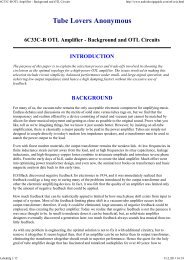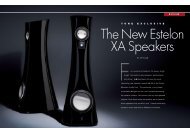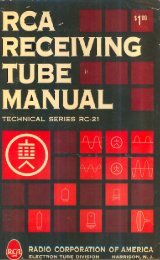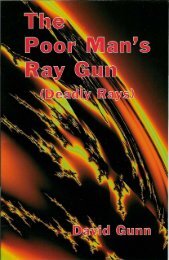- Page 2 and 3:
Build Your OwnElectric Vehicle
- Page 5 and 6:
Copyright © 2009 by The McGraw-Hil
- Page 7 and 8:
For more information about this tit
- Page 9 and 10:
ContentsviiRemember the 30 Percent
- Page 11 and 12:
Contentsix8 Batteries .............
- Page 14 and 15:
xiiContentsChargers ...............
- Page 18 and 19:
xviPrefaceFi g u r e 2 TH!NK City c
- Page 20 and 21:
This page intentionally left blank
- Page 22 and 23:
xxAcknowledgmentscar conversions fo
- Page 24 and 25:
This page intentionally left blank
- Page 26 and 27:
2 Build Your Own Electric Vehicleco
- Page 28 and 29:
4 Build Your Own Electric VehicleFi
- Page 31 and 32:
Chapter 1: Why Electric Vehicles Ar
- Page 33 and 34:
Chapter 1: Why Electric Vehicles Ar
- Page 35 and 36:
Chapter 1: Why Electric Vehicles Ar
- Page 37 and 38: Chapter 1: Why Electric Vehicles Ar
- Page 39 and 40: Chapter 1: Why Electric Vehicles Ar
- Page 41 and 42: Chapter 1: Why Electric Vehicles Ar
- Page 43 and 44: Chapter 1: Why Electric Vehicles Ar
- Page 45 and 46: CHAPTER 2Electric VehiclesSave the
- Page 47 and 48: Chapter 2: Electric Vehicles Save t
- Page 49 and 50: Chapter 2: Electric Vehicles Save t
- Page 51 and 52: Chapter 2: Electric Vehicles Save t
- Page 53 and 54: Chapter 2: Electric Vehicles Save t
- Page 55 and 56: CHAPTER 3Electric Vehicle History
- Page 58 and 59: 34 Build Your Own Electric Vehiclea
- Page 60 and 61: 36 Build Your Own Electric VehicleF
- Page 62 and 63: 38 Build Your Own Electric Vehiclea
- Page 64 and 65: 40 Build Your Own Electric Vehiclet
- Page 66 and 67: 42 Build Your Own Electric VehicleI
- Page 68 and 69: 44 Build Your Own Electric VehicleF
- Page 70 and 71: 46 Build Your Own Electric VehicleE
- Page 72 and 73: 48 Build Your Own Electric VehicleF
- Page 74 and 75: 50 Build Your Own Electric VehicleJ
- Page 76 and 77: 52 Build Your Own Electric Vehiclee
- Page 78 and 79: 54 Build Your Own Electric VehicleF
- Page 80 and 81: 56 Build Your Own Electric VehicleK
- Page 82 and 83: 58 Build Your Own Electric Vehicle
- Page 84 and 85: 60 Build Your Own Electric VehicleM
- Page 86 and 87: 62 Build Your Own Electric VehicleF
- Page 90 and 91: 66 Build Your Own Electric VehicleF
- Page 92 and 93: 68 Build Your Own Electric VehicleF
- Page 94 and 95: 70 Build Your Own Electric VehicleF
- Page 96 and 97: 72 Build Your Own Electric Vehicleo
- Page 98 and 99: 74 Build Your Own Electric VehicleA
- Page 100 and 101: 76 Build Your Own Electric VehicleF
- Page 102 and 103: 78 Build Your Own Electric Vehiclet
- Page 104 and 105: 80 Build Your Own Electric VehicleF
- Page 106 and 107: 82 Build Your Own Electric VehicleF
- Page 108 and 109: 84 Build Your Own Electric VehicleF
- Page 110 and 111: 86 Build Your Own Electric Vehiclep
- Page 112 and 113: 88 Build Your Own Electric VehicleY
- Page 114 and 115: 90 Build Your Own Electric Vehiclec
- Page 116 and 117: 92 Build Your Own Electric VehicleE
- Page 118 and 119: This page intentionally left blank
- Page 120 and 121: 96 Build Your Own Electric Vehiclei
- Page 122 and 123: 98 Build Your Own Electric Vehicle1
- Page 124 and 125: 100 Build Your Own Electric Vehicle
- Page 126 and 127: 102 Build Your Own Electric Vehicle
- Page 128 and 129: 104 Build Your Own Electric Vehicle
- Page 130 and 131: 106 Build Your Own Electric Vehicle
- Page 132 and 133: 108 Build Your Own Electric Vehicle
- Page 134 and 135: 110 Build Your Own Electric Vehicle
- Page 136 and 137: 112 Build Your Own Electric Vehicle
- Page 138 and 139:
114 Build Your Own Electric Vehicle
- Page 140 and 141:
116 Build Your Own Electric Vehicle
- Page 142 and 143:
118 Build Your Own Electric Vehicle
- Page 144 and 145:
120 Build Your Own Electric Vehicle
- Page 146 and 147:
122 Build Your Own Electric Vehicle
- Page 148 and 149:
124 Build Your Own Electric Vehicle
- Page 150 and 151:
126Vehicle gear 1st 1st 2nd 2nd 3rd
- Page 152 and 153:
128 Build Your Own Electric Vehicle
- Page 154 and 155:
130 Build Your Own Electric Vehicle
- Page 156 and 157:
This page intentionally left blank
- Page 158 and 159:
134 Build Your Own Electric Vehicle
- Page 160 and 161:
136 Build Your Own Electric Vehicle
- Page 162 and 163:
138 Build Your Own Electric Vehicle
- Page 164 and 165:
140 Build Your Own Electric Vehicle
- Page 166 and 167:
142 Build Your Own Electric Vehicle
- Page 168 and 169:
144 Build Your Own Electric Vehicle
- Page 170 and 171:
146 Build Your Own Electric Vehicle
- Page 172 and 173:
148 Build Your Own Electric Vehicle
- Page 174 and 175:
150 Build Your Own Electric Vehicle
- Page 176 and 177:
152 Build Your Own Electric Vehicle
- Page 178 and 179:
154 Build Your Own Electric Vehicle
- Page 180 and 181:
156 Build Your Own Electric Vehicle
- Page 182 and 183:
158 Build Your Own Electric Vehicle
- Page 184 and 185:
160 Build Your Own Electric Vehicle
- Page 186 and 187:
162 Build Your Own Electric Vehicle
- Page 188 and 189:
164 Build Your Own Electric Vehicle
- Page 190 and 191:
166 Build Your Own Electric Vehicle
- Page 192 and 193:
168 Build Your Own Electric Vehicle
- Page 194 and 195:
170 Build Your Own Electric Vehicle
- Page 196 and 197:
172 Build Your Own Electric Vehicle
- Page 198 and 199:
174 Build Your Own Electric Vehicle
- Page 200 and 201:
176 Build Your Own Electric Vehicle
- Page 202 and 203:
178 Build Your Own Electric Vehicle
- Page 204 and 205:
180 Build Your Own Electric Vehicle
- Page 206 and 207:
182 Build Your Own Electric Vehicle
- Page 208 and 209:
184 Build Your Own Electric Vehicle
- Page 210 and 211:
186 Build Your Own Electric Vehicle
- Page 212 and 213:
188 Build Your Own Electric Vehicle
- Page 214 and 215:
190 Build Your Own Electric Vehicle
- Page 216 and 217:
192 Build Your Own Electric Vehicle
- Page 218 and 219:
194 Build Your Own Electric Vehicle
- Page 220 and 221:
196 Build Your Own Electric Vehicle
- Page 222 and 223:
198Trojan Minutes Minutes Weight En
- Page 224 and 225:
200 Build Your Own Electric Vehicle
- Page 226 and 227:
202Nominal Cell Operating Theoretic
- Page 228 and 229:
204 Build Your Own Electric Vehicle
- Page 230 and 231:
206 Build Your Own Electric Vehicle
- Page 232 and 233:
208 Build Your Own Electric Vehicle
- Page 234 and 235:
210 Build Your Own Electric Vehicle
- Page 236 and 237:
212 Build Your Own Electric Vehicle
- Page 238 and 239:
214 Build Your Own Electric Vehicle
- Page 240 and 241:
216 Build Your Own Electric Vehicle
- Page 242 and 243:
218 Build Your Own Electric Vehicle
- Page 244 and 245:
220 Build Your Own Electric Vehicle
- Page 246 and 247:
222 Build Your Own Electric Vehicle
- Page 248 and 249:
224 Build Your Own Electric Vehicle
- Page 250 and 251:
226 Build Your Own Electric Vehicle
- Page 252 and 253:
228 Build Your Own Electric Vehicle
- Page 254 and 255:
230 Build Your Own Electric Vehicle
- Page 256 and 257:
232 Build Your Own Electric Vehicle
- Page 258 and 259:
234 Build Your Own Electric Vehicle
- Page 260 and 261:
236 Build Your Own Electric Vehicle
- Page 262 and 263:
238 Build Your Own Electric Vehicle
- Page 264 and 265:
240 Build Your Own Electric Vehicle
- Page 266 and 267:
242 Build Your Own Electric Vehicle
- Page 268 and 269:
244 Build Your Own Electric Vehicle
- Page 270 and 271:
246 Build Your Own Electric Vehicle
- Page 272 and 273:
248 Build Your Own Electric Vehicle
- Page 274 and 275:
250 Build Your Own Electric Vehicle
- Page 276 and 277:
252 Build Your Own Electric Vehicle
- Page 278 and 279:
254 Build Your Own Electric Vehicle
- Page 280 and 281:
256 Build Your Own Electric Vehicle
- Page 282 and 283:
258 Build Your Own Electric Vehicle
- Page 284 and 285:
260 Build Your Own Electric Vehicle
- Page 286 and 287:
262 Build Your Own Electric Vehicle
- Page 288 and 289:
264 Build Your Own Electric Vehicle
- Page 290 and 291:
266 Build Your Own Electric Vehicle
- Page 292 and 293:
268 Build Your Own Electric Vehicle
- Page 294 and 295:
270 Build Your Own Electric Vehicle
- Page 296 and 297:
272 Build Your Own Electric Vehicle
- Page 298 and 299:
274 Build Your Own Electric Vehicle
- Page 300 and 301:
276 Build Your Own Electric Vehicle
- Page 302 and 303:
278 Build Your Own Electric CarFi g
- Page 304 and 305:
280 Build Your Own Electric CarEast
- Page 306 and 307:
282 Build Your Own Electric CarGeor
- Page 308 and 309:
284 Build Your Own Electric CarOreg
- Page 310 and 311:
286 Build Your Own Electric CarPlug
- Page 312 and 313:
288 Build Your Own Electric CarGove
- Page 314 and 315:
290 Build Your Own Electric CarCush
- Page 316 and 317:
292 Build Your Own Electric CarGras
- Page 318 and 319:
294 Build Your Own Electric Car3E V
- Page 320 and 321:
296 Build Your Own Electric CarEV S
- Page 322 and 323:
298 Build Your Own Electric CarPaul
- Page 324 and 325:
300 Build Your Own Electric CarCurt
- Page 326 and 327:
302 Build Your Own Electric CarAvco
- Page 328 and 329:
304 Build Your Own Electric CarLead
- Page 330 and 331:
306 Build Your Own Electric CarGras
- Page 332 and 333:
308 Build Your Own Electric Car•
- Page 334 and 335:
310 Build Your Own Electric CarAsso
- Page 336 and 337:
This page intentionally left blank
- Page 338 and 339:
314 IndexAssociation for Electric a
- Page 340 and 341:
316 Indexbuying an EV. See purchasi
- Page 342 and 343:
318 Indexcosts (continued)EV conver
- Page 344 and 345:
320 Indexelectrical system (continu
- Page 346 and 347:
322 IndexGGage, Tom, 69Galvani, Lui
- Page 348 and 349:
324 Indexlithium-ion batteries, 9,
- Page 350 and 351:
326 IndexPlymouth Arrow, 84pollutio
- Page 352 and 353:
328 IndexTaylor, Carl, 294Technolog
- Page 354:
This page intentionally left blank


